5-1 Language and Communication
A – The Head Start Early Learning Outcomes Framework
The Head Start Early Learning Outcomes Framework (HSELOF) preschool Language and Literacy domain is divided into two sections: Language and Communication, and Literacy.
In this section, we will focus on language and communication. The Language and Communication domain includes the development of key language and communication skills, including attending to communication and language from others, using and following appropriate social and conversational rules, and understanding and using a wide variety of words.

For example, the developmental progression of the Attending and Understanding subdomain shows the growth from acknowledging, understanding, and responding to comments or questions to attending to multi-turn conversations, understanding complex statements, questions, and stories, and responding appropriately.
The Language and Communication domain encompasses three subdomains. As mentioned, one subdomain is Attending and Understanding. The other two are: Communicating and Speaking, and Vocabulary.
We will now cover language development within each of these subdomains.
Attending and Understanding
Between 3 and 5 years, children are able, for the first time, to attend to and understand more complex language, such as statements, questions, and stories that contain multiple phrases and ideas. Children also learn to follow and participate in multi-turn conversations—ones where a child and their conversation partner go back and forth several times.
During this time in development, children also gain skills in understanding and remembering multi-step instructions.
Developing Conversations
Between 3 and 4 years, children will begin to answer simple who, what, and where questions.
They also begin to understand and talk about events that happened in the past or future events. For example, a child might be able to talk about how they got to school that morning or understand that their aunt is going to pick them up at the end of the day.
Children at this age show an acknowledgement of comments or questions, using verbal or non-verbal signals or both.
Between 4 and 5 years, children’s ability to understand and answer questions grows to include more complicated questions like: “How?” For example, they may say, “How do you make a block tower really tall?” or “How do you get ready to go outside when it is raining?”
Understanding Instructions
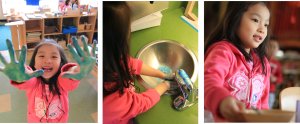
Children also are able to remember multi-step directions in order. For example, a 3-year-old child will probably not be able to remember a three- or even two-step set of instructions: “Wash your hands, then go get your dish for lunch.”
But by 5 years, children can often recall two- or three-step directions or actions. Between 4 and 5 years, educators can begin to ask students to do simple two- to three-step actions.
Take a moment to think about how you might talk to a 3-year-old about getting ready to clean up and eat lunch, versus how you might talk to a 4-year-old about getting ready for lunch.
Developing Questions
During the first 5 years of life, children’s question-asking behavior grows in complexity. Children not only ask more questions, but the type of questions they ask represents both their developing language and developing cognitive skills.
One example of the growing sophistication of children’s questions is shown in the graph here. This study looked at what percentage of questions were stand-alone or isolated questions like “What is that?” and then “What is this?” versus questions that build on each other like “What is that?” and “What does it do?”
As the term suggests, building questions build on one another; each question relates to the information from the previous question.
In contrast, isolated questions stand alone. Think of a toddler asking, “What is that?” while pointing to a vacuum, and then asking again, “What is this?” while pointing to a picture of a turtle. Those questions do not relate to one another.
Older children will often ask streams of questions on the same topic or about the same object, such as ”What is that?” while pointing to the vacuum, then “What does it do?” followed by “Why do we need to do that?”
 Interactive: Developing Questions
Interactive: Developing Questions
This is an interactive! Use the slider in the interactive to explore the graph.
Video: Rainbow Fish Activity (3:00)
During this period in development, children are developing their abilities to listen and pay attention to longer conversations that include multiple turns or rounds. And they can understand more complex statements, questions, and stories.
Let’s watch this video, Rainbow Fish Activity, of an educator in an early learning program talking about a book that the group just read.
Think about these questions while you watch the next video:
- What do the children’s responses tell us about their language development?
- How does the educator support their learning?

Video Debrief
Here are some things that we noticed: (click to toggle expand or collapse)
- What do the children’s responses tell us about their language development? Children are responding to questions with complex answers such as, “Octopus wants fish to share his scales,” and they are reconstructing a story from memory.
- How does the educator support children’s learning? One answer is with open-ended, prompting questions such as, “Then what happens?” followed by a response meant to encourage children’s further responses. For example, if a child says, “Share” in response to “What happens next?” the educator might say, “Oh, share, yeah, what does the octopus want to share?”
B – Communicating and Speaking
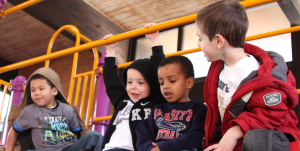
The Communicating and Speaking subdomain includes skills that are important for sharing meaningful information.
Between 3 and 5 years, children develop some fairly sophisticated communication skills, such as varying how much information they give, depending on what they are talking about and whom they are talking with. They also show growth in their understanding and use of social rules and norms, including common conversational rules. And they are gaining skills in self-expression.
Communicating with Others
Between 3 and 4 years, children begin to describe what their needs are and to communicate them with enough information to get help from a variety of adults.
For example, at this age a child might ask for a snack in different ways depending on who they are talking to. At home, the child may just tell their mom that they are thirsty. In their early learning program, they might be more specific and ask their educator for a cup of water because they know from prior experience that water is what is available when they are thirsty between meals.
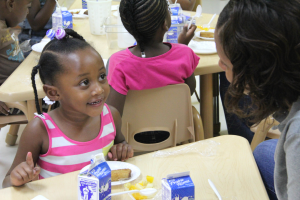
During this year in development, children also start to have longer back-and-forth exchanges in their conversations and begin to use the appropriate tone or volume of voice for the situation. They may know, for instance, that conversations outside can be loud, but conversations inside should be a little quieter.
Children can string together three to five words at this age. Their communication abilities allow them to be understood by familiar adults. However, adults who don’t know the child well may still have trouble understanding what the child is saying.

Reflection Point
There is a huge amount of growth that happens in children’s language, especially in how they use narratives during conversations.
Consider the two conversations below. One is with a 3-year-old, and the other is with a 4-year-old.
3-Year-Old
Child: You know what I was doing?
Adult: What?
Child: I was doing my work.
Adult: Your work?
Child: Like I do at home.
4-Year-Old
Child: I have two sisters, one with blonde hair like me’m the other with long black hair. ‘N the one with black hair, when she was 4 like me, she cut her hair with scissors that aren’t for cutting hair. ‘N now she has short hair.
What skills are children developing in these years that allow them to have longer conversations? Think about skills that might not necessarily directly link to language. Possible responses to this question include: Memory, vocabulary, and understanding of social cues.
Have you noticed similar growth in the children that you work with?
C – Becoming Conversationalists
Between the ages of 4 and 5, children grow and gain new skills in their conversational abilities. Notably, by the end of their fifth year, children are becoming sophisticated conversationalists, using skills like asking questions related to the conversation to continue the discussion.
Children of this age are also able to match the tone and volume of their conversational partner. And they have some idea about what types of conversation styles or information other people might need.
Adjusting Conversation
Multiple studies have explored children’s ability to tailor the style of their conversation to their partner. For example, one study asked 4-year-old children to describe how a toy dumping station worked to two different audiences—their mother and a 2-year-old child.
The study found that 4-year-olds changed how they described the toy depending on who they were talking to. When the children were talking to adults, they used longer, more complex phrases. When they were talking to 2-year-olds, the children used strategies to get the toddler’s attention like “Look!” and “Watch!”
This suggests that between 4 and 5, children are able to adjust the style of their speech and communication based on who they are talking to. In addition, this is the first time in a child’s development that they will likely be able to communicate clearly enough that adults who are not familiar with them will be able to understand what they are saying.
Vroom Tip
Check out this Vroom tip to get more ideas about how to build communication skills with young children.
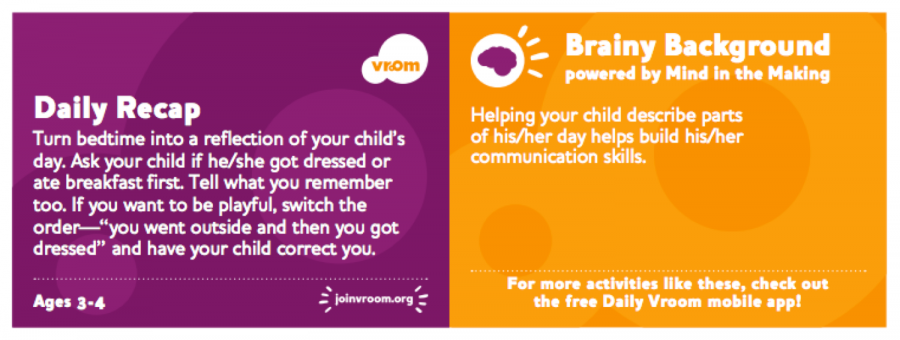
View text-only alternative of this Vroom card
Daily Recap
Turn bedtime into a reflection of your child’s day. Ask your child if he/she got dressed or ate breakfast first. Tell what you remember too. If you want to be playful, switch the order— “you went outside and then you got dressed” and have your child correct you.
Ages 3-4
Brainy Background powered by Mind in the Making
Helping your child describe parts of his/her day helps build his/her communication skills.
Read the Vroom tip. Does this tip make sense in the context of an early learning environment? And if not, how might you adapt the activity to better fit?
D – Vocabulary
The third of the three Language and Communication subdomains is Vocabulary. Between 3 and 5 years, children show a large increase in their vocabulary.
Throughout this period, children learn new words that help them describe more aspects of their experience in the world, such as actions, emotions, and ideas. While words describing actions, emotions, and ideas do appear at earlier points in their development, during this period children are using these types of words with more sophistication and in greater quantity.
By age 5, children will typically use two to three new words a day. In addition to learning and using new words, children are also developing their understanding and use of categories.
Learning Categories
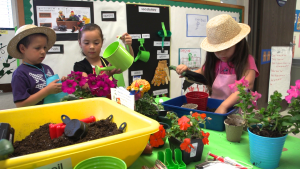
As children learn new words during this period, they will often repeat words that adults say.
Between ages 4 and 5, children’s language skills develop enough to ask adults what new words mean. And by age 5, children are able to use sophisticated context cues like grammar, with support, to guess a word’s meaning.
During this period, children are also building their skills in understanding categories and relationships between words. For example, by age 5, children can sort things by category, like putting the toy shovel, garden hat, and plant in the gardening group. They are also able to give examples of things within categories, such as naming different types of fruits.
Children learn to identify characteristics across groups as well. For example, they may know that trees and flowers both are green and have leaves.
Between 4 and 5 years, children begin to use and understand antonyms for the first time, such as warm and cold or bright and dark, as well as synonyms like warm and hot or large and huge.
Learning Language Structure
Older children can also use what they know about the structure of language to figure out word meanings.
In one study, children saw a hand resting on some material in a bowl. To one group of children, the adult explained that this was a picture of sibbing. To another group, the adult said that this was a picture of some sib. To a third group of children, the adult explained that this was a picture of a sib.
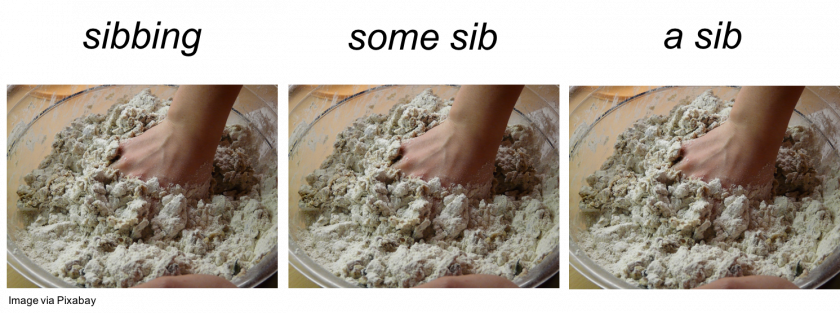
Do you think that the children had different definitions of sib based on what they heard? If you guessed yes, you are right.
The children who were told that this was a picture of sibbing, guessed that sib was an action, sort of like kneading. They knew that words ending in ing are often actions.
The children who heard that this was a picture of some some sib interpreted sib as a word for the material in the bowl. The children knew that some is often is used before a word and usually describes things that you can count or are hard to count. For example, we say that we have some dough not we have a dough.
What do you think the group of children who heard that this was a picture of a sib guessed the meaning of sib was? If you guessed the bowl, that’s exactly what the children in the study guessed too. At this age, children know that a comes before a word and usually describes things that we can count. We would describe this picture as having one bowl in it.
Video: Hibernation (3:31)
This video of children learning a new word is called Hibernation. While watching the video, observe the educator and children. Then think about these questions:
- What tools did this educator use to help children learn the new vocabulary word?
- What would you do to help these children deepen their learning?

Video Debrief
What tools did this educator use to help children learn the new vocabulary word, hibernation? (click to toggle expand or collapse)
Some possible answers are:
- Repetition
- Phonological awareness (sounding out the letters)
- Language structure cues (bears hibernate, hamsters hibernate), verb structure
- Images to engage the children
 References
References
Berk, L. (2013). Child development (9th ed.). Pearson.
Brown, R. (1957). Linguistic determinism and the part of speech. Journal of Abnormal and Social Psychology, 55(1), 1–5.
Chouinard, M. M., Harris, P. L., & Maratsos, M. P. (2007). Children’s questions: A mechanism for cognitive development. Monographs of the Society for Research in Child Development, 72(1), 1–129.
Cultivate Learning (Producer). (2017). Hibernation. University of Washington. [Video File]
Cultivate Learning (Producer). (2017). Rainbow fish activity. University of Washington. [Video File]
National Association for the Education of Young Children. (2013). Many languages, one teacher: Supporting language and literacy development for preschool dual language learners. Young Children, 68(1), 8–12.
Shatz, M., & Gelman, R. (1973). The development of communication skills: Modifications in the speech of young children as a function of the listener. Monographs of the Society for Research in Child Development, 38(5), 1–38.
Umiker-Sebeok, D. J. (1979). Preschool children’s intraconversational narratives. Journal of Child Language, 6(1), 91–110.
U.S. Department of Health and Human Services, Administration for Children and Families, Office of Head Start. (n.d.). Head Start Early Learning Outcomes Framework: Ages birth to five. [Website]
Vroom (2017). Tools and activities. [Website]
EarlyEdU Alliance (Publisher). (2018). 5-1 Language and communication. In Child Development: Brain Building Course Book. University of Washington. [UW Pressbooks]

